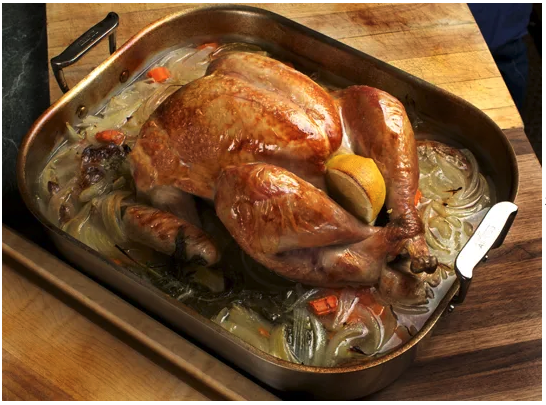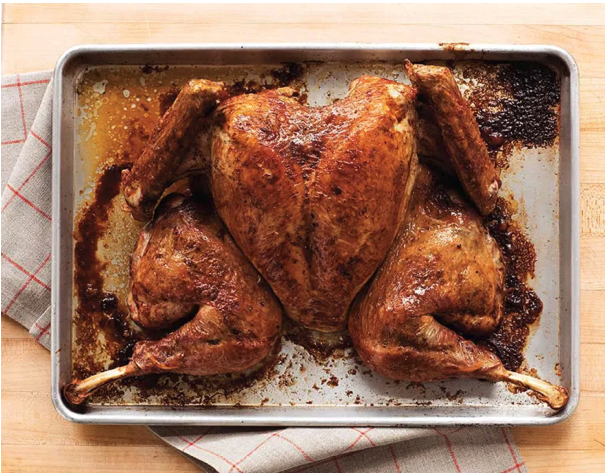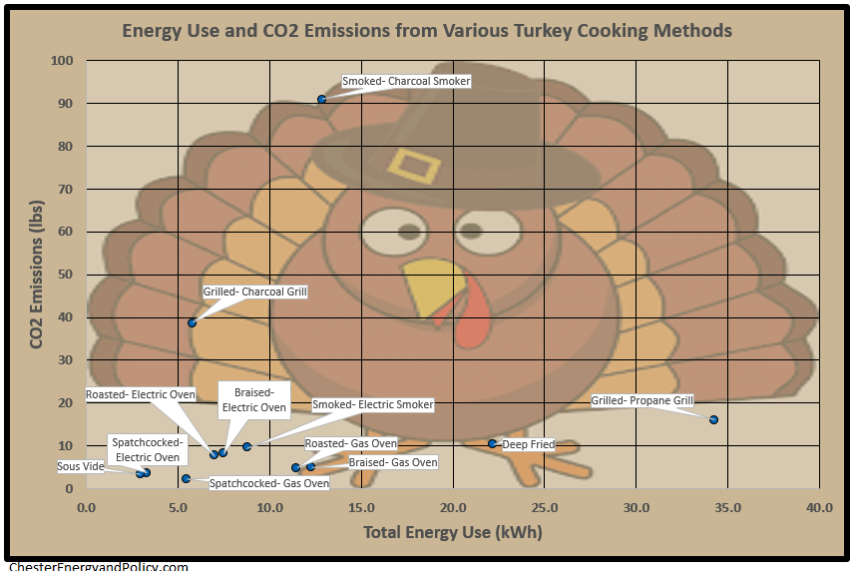Thanksgiving Redux: Embedded Energy & Carbon Emissions of Turkey Cooking Methods
With Thanksgiving upon us once again, I hope you’re getting a chance to spend some treasured time with your loved ones and are also able to load up the traditional holiday meal with all its fixings. In celebration of what’s always among my favorite days of the year, and to enable me the time to spend with my family instead of in front of the computer drafting a new energy-related Thanksgiving post, I decided to just run an abbreviated version of my article from last year that analyzed the embedded energy used and carbon dioxide (CO2) emitted from different methods for cooking a Thanksgiving turkey.
That post clocked in at a behemoth in length, so I’ll cut down to the main points and calculations in this shortened version (that way you can spend more time with your family instead of reading it!). But if you want to read all the tiny details and the expansive methodology, head on over to the original version of the article and pore over the numbers for yourself.
And most importantly, have a happy Thanksgiving!
Source: Ruhlman
Recipes
After searching far and wide, I settled on seven different methods to cook Thanksgiving turkey. In addition to the traditional roasting, let’s examine braising, deep frying, grilling, smoking, spatchcocking, and sous vide. For each cooking method, I’ve linked to a recipe from a well-known chef of repute or from the manufacturer of the turkey or cooking apparatus– to see each of those recipes and the decisions behind them in full, please head over to the original full article.
Calculations
The recipes analyzed utilize a variety of cooking apparatuses and fuels, so the methodology of calculating the total energy use and CO2 emissions will vary. But much like the Halloween-themed article on the most sustainable way to light your Jack-O’-Lantern, this analysis will be calculated using very rough estimates and educated assumptions for data inputs– as such, consider them more back-of-the-envelope calculations than scientifically rigorous calculations (and again, to see the numbers worked out in more detail, refer to the full article from last year).
Roasted turkey
Assuming the use of an oven for 3 hours 30 minutes (which includes preheating), the energy use and CO2 emissions depend on whether the oven is powered by gas or electricity.
A typical electric oven of 2.0 kilowatts (kW) would require 7.0 kilowatthours (kWh) of energy. According to the Department of Energy (DOE), electricity generated in the United States releases 1.096 pounds of CO2 per kWh. As such, the emissions footprint for a traditionally roasted turkey is 7.7 lbs of CO2.
U.S. gas ovens use 0.112 therms of natural gas per hour, so this recipe would use 0.392 therms– equivalent to 11.5 kWh of energy. The U.S. Environmental Protection Agency (EPA) says that cooking with natural gas releases 11.7 lbs of CO2 per therm, so the footprint of a roasted turkey in a gas oven is 4.6 lbs of CO2.
Source: Bon Appetit
Braised turkey
Our braised turkey recipe requires the use of an oven for 3 hours 45 minutes. As such, we can simply scale up our roasted turkey calculations:
Braised turkey in an electric oven accounts for 7.5 kWh of energy and 8.2 lbs of CO2 emissions.
In a gas oven, this braised turkey uses 12.3 kWh of energy and releases 4.9 lbs of CO2.
Deep fried turkey
The recipe for deep fried turkey calls for a propane heater to cook a pot of oil for 1 hour 10 minutes (preheating and cooking time included). Based on the assumption that propane cookers use 65,000 British thermal units (BTUs) per hour and converting to kWh, deep fried turkey uses the equivalent of 22.2 kWh of energy.
Referring back to EPA data on carbon emissions of cooking equipment that note 1,000,000 BTUs of propane burned emits 136.05 lbs of CO2, this deep fried turkey thus emits 10.3 lbs of CO2.
Source: Food Network
Grilled turkey
If we grill a turkey on a charcoal grill, manufacturers suggest the use of 110 charcoal briquettes burned over 3 hours with 30 minutes of pre-burning. Given 7.33 kilojoules (kJ) per gram of charcoal and briquettes that weigh 25.7 grams, the charcoal grilled turkey would use 20,733 kJ or 5.8 kWh of energy. According to Oak Ridge National Laboratory, operating a charcoal grill for an hour emits 11 lbs of CO2, meaning the charcoal grill method for preparing a turkey requires 38.5 lbs of CO2 emissions.
If we instead use a propane grill, total grill time would be 3 hour 15 minutes at an energy rate of 36,000 BTU/hour for an equivalent of 34.3 kWh of energy. EPA’s emissions data then indicates propane-grilled turkey would release 15.9 lbs of CO2.
Smoked turkey
One method for smoking a turkey uses a charcoal powered water smoker, requiring 10 lbs plus 70 briquettes of charcoal burned over an 8 hour 15 minute period. Based on the assumptions listed in the charcoal grill method previously discussed, total energy use would be 12.9 kWh and emissions would reach 90.8 lbs of CO2.
Conversely, culinary aficionados could utilize an 800 watt electric smoker for 11 hours, requiring the use of 8.8 kWh and emitting 9.6 lbs of CO2.
Spatchcocked turkey
Spatchcocking is a more newly popular method to speed up the turkey cooking process, requiring just 1 hour 40 minutes in the oven. Returning to our previous assumptions for electric and gas ovens, the calculations show:
Spatchcocked turkey in an electric oven would require 3.3 kWh of energy and account for 3.6 lbs of CO2.
The same recipe in a gas oven would use the equivalent of 5.5 kWh and emit 2.2 lbs of CO2.
Source: The Bitten World
Sous vide turkey
Last but not least is the sous vide turkey, which requires the use of an immersion sous vide immersion circulator for a total of 2 hours 45 minutes. Given a power rating on the Williams Sonoma circulator of 1,100 W, this cooking methods requires 3.0 kWh of energy and accounts for 3.3 lbs of CO2 emissions.
Graphical results and conclusions
With all those calculations and assumptions out of the way, we can finally look at all the results on one table:
These numbers can also be displayed graphically to show the overall level of ‘green-ness’ of each cooking method:
These numbers allow us to hone in on some interesting conclusions:
To minimize the CO2 emissions from your Thanksgiving turkey, the most important aspect is not cooking with charcoal– either the smoked or grilled recipes using charcoal– as charcoal is one of the most carbon intensive fuels used commonly in homes.
On a pure energy-use basis, the two options that require cooking with propane– deep fried and grilled on a propane grill– clock in as the most energy-intensive because propane burners are typically only 40% efficient with the remaining energy output being wasted.
The most energy and emissions friendly cooking methods are sous vide and spatchcocking. Sous vide enables efficient cooking because the turkey is vacuum sealed and cooked in the smallest size enclosure meaning waste heat is minimized. Spatchcocking a turkey before cooking, meanwhile, benefits from reduced cooking time due to the increased surface area being cooked.
When comparing the recipes that use either the gas oven or the electric oven, the final figures show that the gas ovens use more energy but emit less CO2. What is important to note about the CO2 difference, however, is that the numbers are based on the average U.S. figure for CO2 emitted per kWh. This number can vary greatly depending on your power company and where you live. For example, if you live in Vermont then your power likely comes from a greater proportion of renewable energy than in other states, which would reduce the relative CO2 emissions of your electric oven. Of course the opposite is true if your power company uses more coal in its fuel mix than the national average.
Source: Ruhlman
According to the National Turkey Federation, 46 million turkeys are roasted each Thanksgiving, and estimates of energy use to cook those turkeys ranges from 48 million kWh to 792 million kWh. Concerning emissions, the 46 million turkeys could account for 152 million lbs (sous vide) or over 4 billion lbs (grilled on charcoal grill) of CO2 (for context, a passenger vehicle emits about 10,000 lbs of CO2 per year). That’s all to say, the small decisions everybody makes individually can add up to make a large difference in total energy use or CO2 emitted– even when simply cooking turkey.
In the end, though, there isn’t too much reason for you to stress. There are plenty of methods you can use to cut down on energy use while cooking if you choose to do so (see some examples here and here, or you can even invest in a solar cooker that uses just the sun and reflectors). But ultimately overall energy use on Thanksgiving is lower than the average Thursday. It’s a time to relax and be grateful, not necessarily to measure out your exact charcoal briquettes to minimize energy use. You can, however, come to the Thanksgiving table with some of these fun facts handy to impress your family, just be sure to praise the cooking of the chef first– he or she spent plenty of time and energy preparing that dinner!








